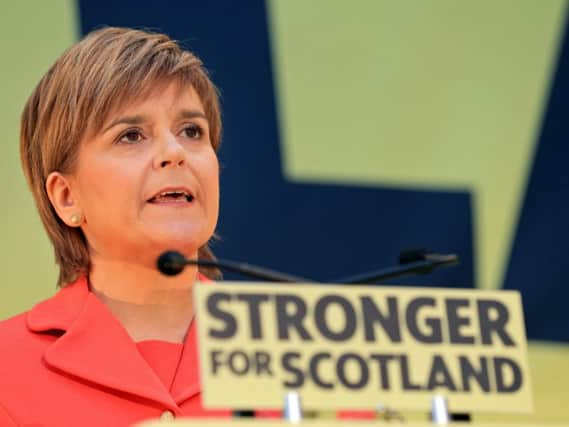Leaders: Nicola Sturgeon in a win-win situation


What we can predict with some certainty is that the undisputed winner of the 2015 general election will be Nicola Sturgeon.
The SNP leader goes into the final week of campaigning with the quiet certainty that, whatever the eventual outcome, she is in a win-win situation.
Advertisement
Hide AdAdvertisement
Hide AdIf Ed Miliband emerges as prime minister, it is likely to be with the help of SNP MPs, who look set to destroy Labour’s grip on its traditional Scottish heartlands.
The endless speculation about Labour-SNP “deals” is in many ways a red herring – the SNP has already indicated it would support Mr Miliband in a Queen’s Speech, and thus help him into Downing Street.
The real SNP influence on government would come during the course of the parliament, with the Nationalists able to withhold support for legislation until it was tweaked to their liking.
Whether this relationship went well or badly would be immaterial to the SNP’s prospects.
If it went well it would maximise SNP influence on both reserved and devolved matters. If it went badly – for example, if the two parties fell out over issues such as Trident or austerity – the Nationalists could present themselves as standing up for Scottish interests while Labour sided with the Tories.
If David Cameron is the man standing on the steps of Downing Street once negotiations in a hung parliament are complete, Ms Sturgeon would still be the winner.
Because this would underline the SNP’s most potent argument for independence – that Scotland does not always get the government it voted for.
The first minister has said she would only opt for another independence referendum if there was a “material change” in circumstances. The referendum on EU membership that Mr Cameron has promised, and the risk of a Brexit against Scottish wishes, is exactly such a material change.
Advertisement
Hide AdAdvertisement
Hide AdThe very fact of five more years of Tory government – with its renewed assault on welfare – would be likely to boost support for independence to a level where it would be hard to resist another shot at the big prize.
This win-win scenario for Ms Sturgeon is quite apart from any assessment of how she has conducted herself in recent months.
She has been the darling of the London media, in large part because of her novelty value but also because of her obvious skill, intelligence and poise. We Scots were already familiar with her after eight years of SNP rule north of the Border, and friend and foe alike have always been in agreement about her tenacity. But this campaign has helped take her popularity among Scottish voters to unprecedented levels.
All in all, a good campaign for Nicola Sturgeon.
Don’t ditch the duck
AT FIRST glance it is a statue of a man that few people will recognise – and then your eye is caught by the duck.
Designs for a new statue to railway pioneer Sir Nigel Gresley at London’s Kings Cross station use a trick that has been common in sculptures of historical figures for centuries – include an animal.
In Washington DC, the monument to Franklin D Roosevelt features his beloved Scotch terrier Fala. On Edinburgh’s Princes Street, the statue of Walter Scott at the heart of the eponymous monument features his faithful pet deerhound, Maida. These additions often become as popular as the depictions of the people next to them.
But not everyone sees the charm in this technique.
Relatives of Sir Nigel suggested the inclusion of the duck – a visual pun on Mallard, the name of one of his most famous steam engines – would invite ridicule and “detract from its dignity”.
They were successful in having it removed from the design. But now other people are backing the duck and calling for its reinstatement.
Advertisement
Hide AdAdvertisement
Hide AdCampaigner Libby Ranzetta said: “It sparks interest in, and curiosity about, the statue and the man. Very few people alive today would recognise a likeness of Gresley. Even little children will want to know why the duck is there.”
She is right. The duck is the difference between a statue and a landmark. It does what all good art is meant to do – it poses a question.
The Gresley family objected for the best-intentioned reasons. But efforts should be made to persuade them that the mallard will enhance his reputation.
Don’t ditch the duck.